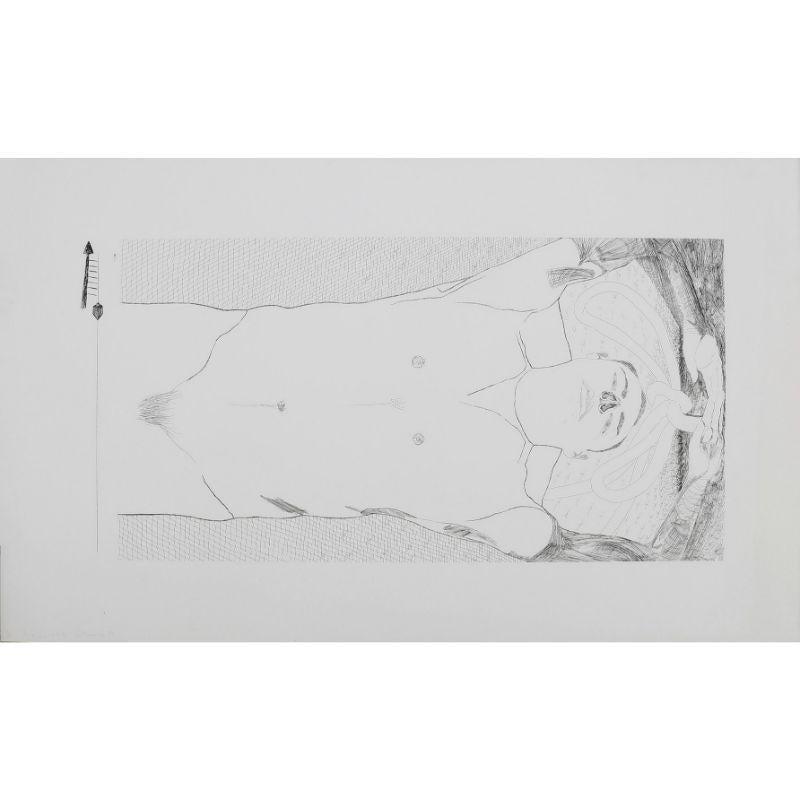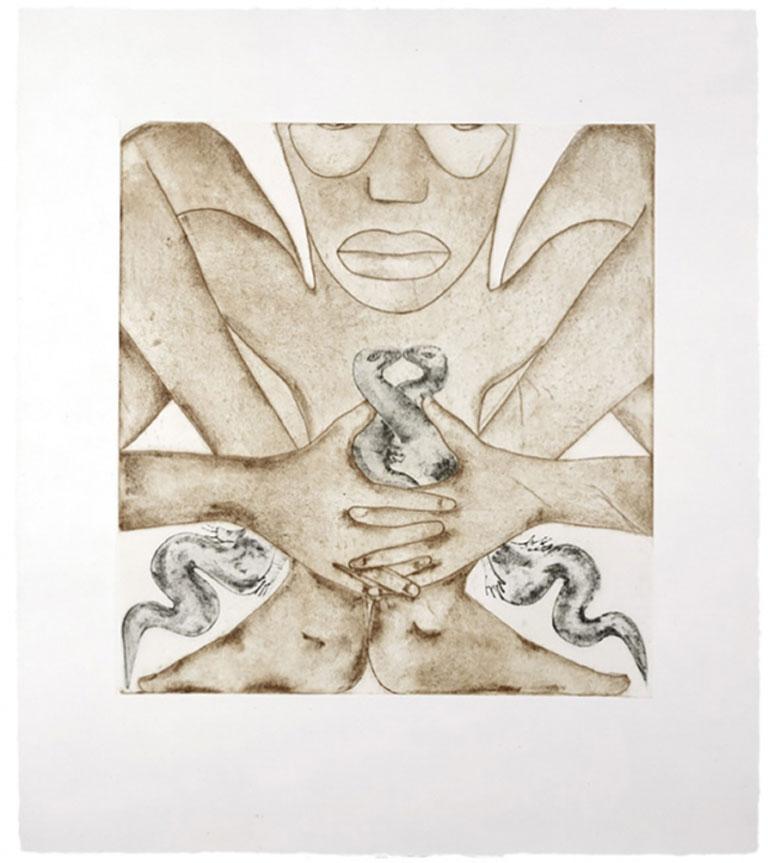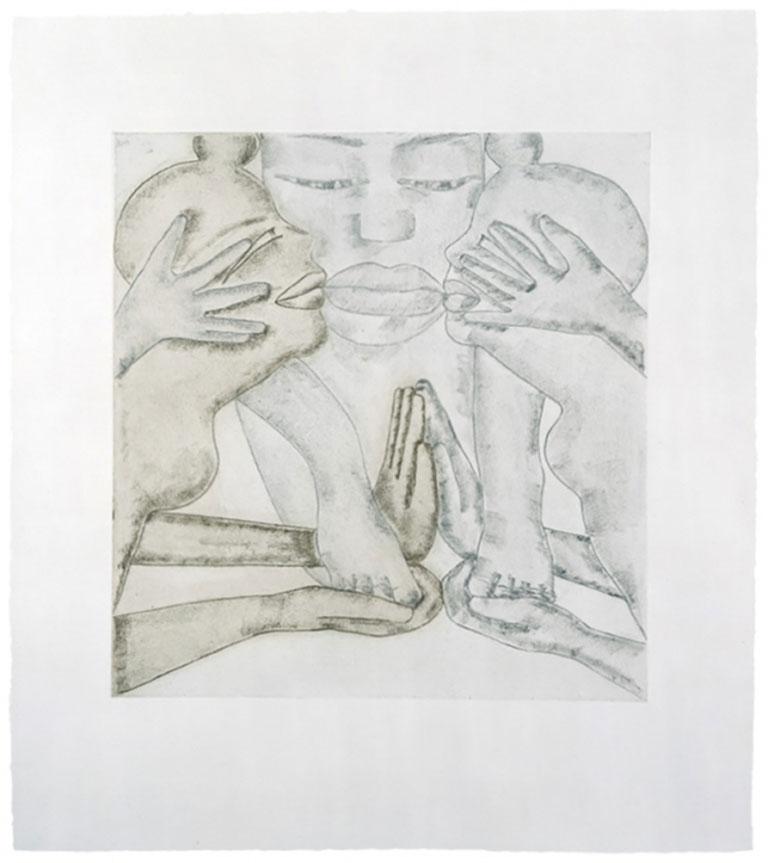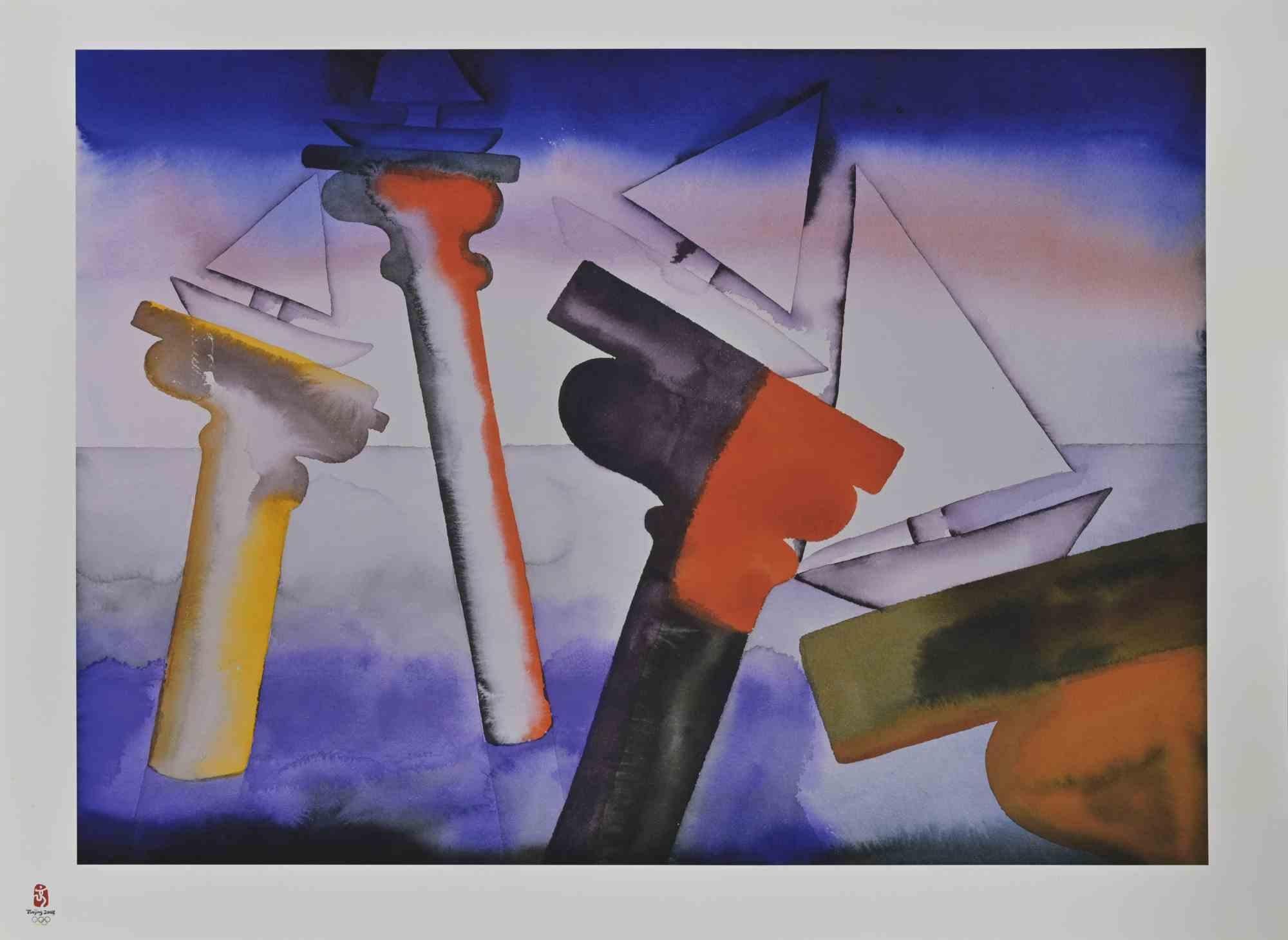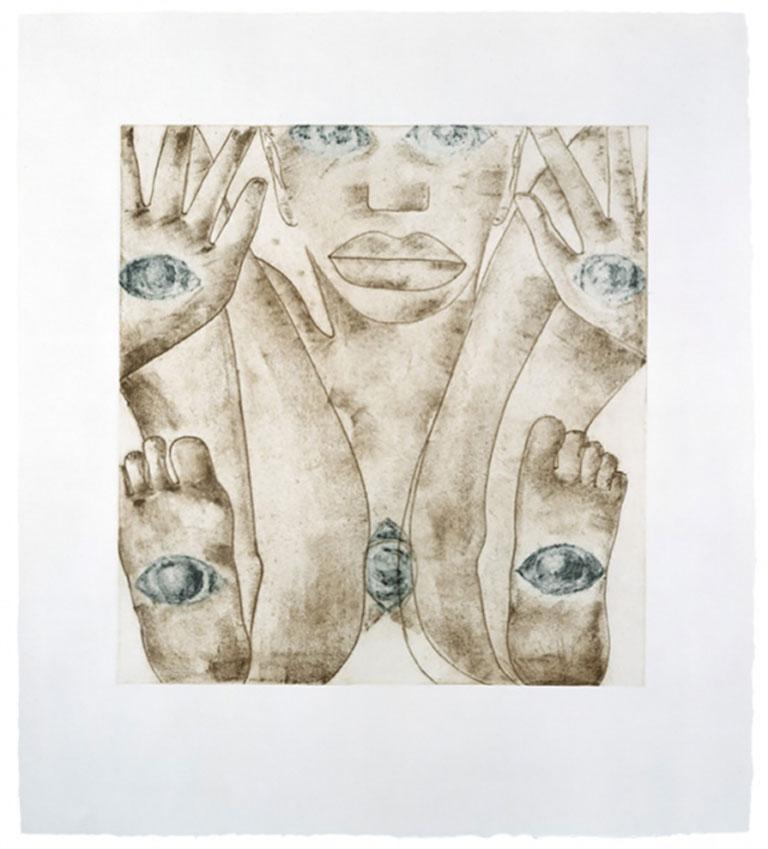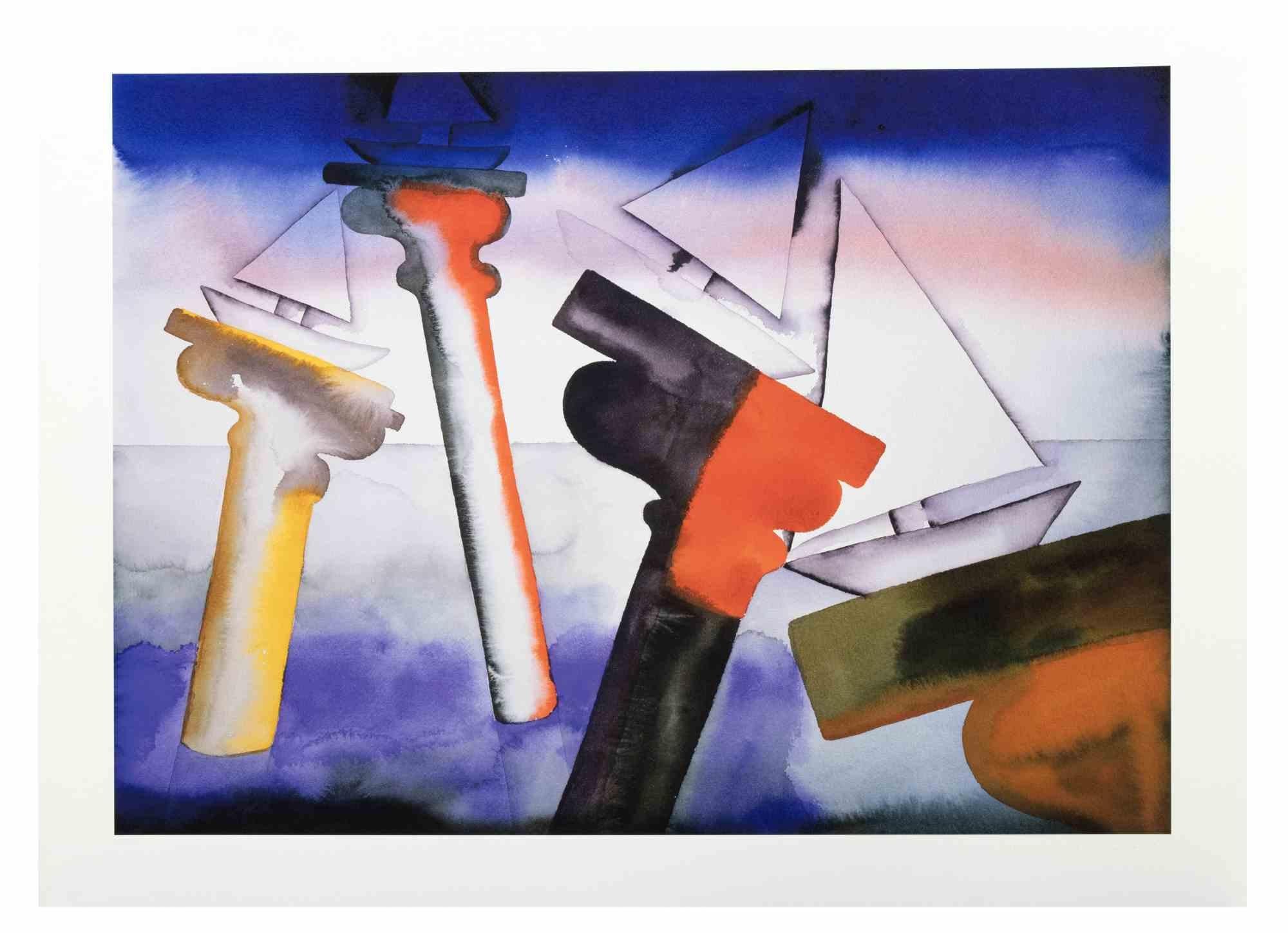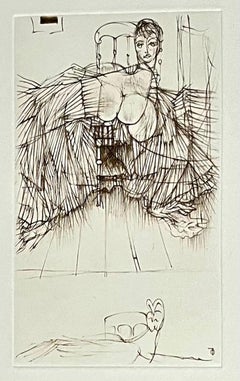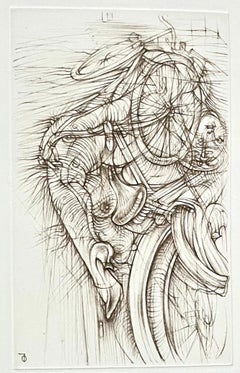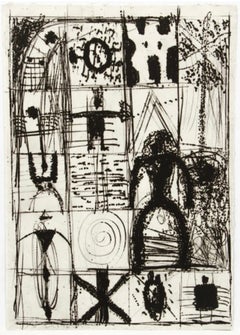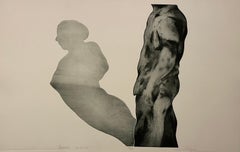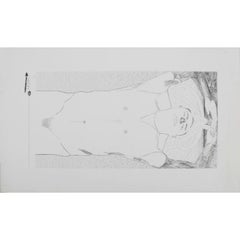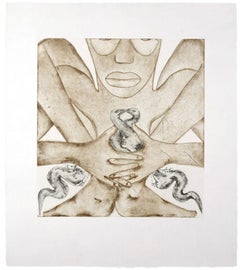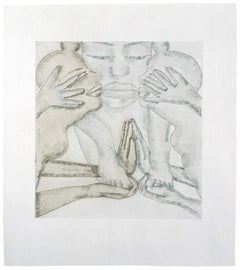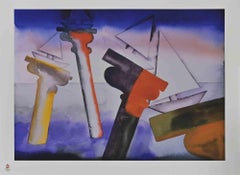Items Similar to Large Italian Aquatint Etching Francesco Clemente Neo Expressionist Avant Garde
Want more images or videos?
Request additional images or videos from the seller
1 of 6
Francesco ClementeLarge Italian Aquatint Etching Francesco Clemente Neo Expressionist Avant Garde1981
1981
$3,600
£2,723.65
€3,143.51
CA$5,028.20
A$5,590.40
CHF 2,926.24
MX$68,564.36
NOK 37,258.37
SEK 35,176.32
DKK 23,457.91
Shipping
Retrieving quote...The 1stDibs Promise:
Authenticity Guarantee,
Money-Back Guarantee,
24-Hour Cancellation
About the Item
Francesco Clemente (Italian b. 1952),
'This side up / Telemone #2,
1981
Medium: Intaglio hard ground etching, color aquatint, drypoint, and soft-ground etching with chine collé (handmade paper) mounted on Arches 88 paper.
Hand signed in pencil and editioned T.P. to lower left, unframed
Printed by Hidekatsu Takada
Published by Crown Point Press, San Francisco
Approximate Dimensions: paper h. 62.5" X 24" Image size: 61 x 19"
Francesco Clemente (born 1952) is an Italian contemporary artist. He has lived at various times in Italy, India and New York City. Some of his work is influenced by the traditional art and culture of India. He has worked in various artistic media including drawing, fresco, graphics, mosaic, oils and sculpture. He was among the principal figures in the Italian Transavanguardia movement of the 1980s, which was characterised by a rejection of Formalism and conceptual art and a return to figurative art and Symbolism
Clemente was born in 1952 in Naples, in Campania in southern Italy. In 1970 he enrolled in the faculty of architecture of the Sapienza, the university of Rome, but did not complete a degree there. In Rome he came into contact with contemporary artists such as Luigi Ontani and Alighiero Boetti, who had come to the city at about the same time, and also with the American Cy Twombly, who lived there. Boetti, who was ten years older, became both a friend and a mentor; in 1974 they visited Afghanistan together. With Ontani, Clemente gave performances at the Galleria L'Attico. Despite his close involvement with these artists associated with the Arte povera movement, and his interest in others such as Pino Pascali and Michelangelo Pistoletto, Clemente preferred to work on paper. He made ink drawings of dreams and recollections of his childhood, and in 1971, in his first solo show, exhibited collages at the Galleria Giulia in Rome. In 1973 Clemente made the first of many visits to India. He established a studio in Madras (now Chennai), and became interested in both the religious and folk traditions of India and in the traditional art and crafts of the country. In 1976 and 1977 he visited the library of the Theosophical Society of Madras to study the religious texts there. In 1980 and 1981 he worked on Francesco Clemente Pinxit, a series of twenty-four gouaches on antique hand-made rag paper, in collaboration with miniature painters from Orissa and Jaipur. In 1982 he moved to New York City. He lives in Greenwich Village.
The eighties were dominated largely by Neo-Expressionist paintings. There were Germans, such as Georg Baselitz, Anselm Kiefer, Gerhard Richter, A. R. Penck, and the Italians, Francesco Clemente, Sandro Chia, Enzo Cucchi, Mimmo Paladino as well as Julian Schnabel, Eric Fischl, Jean Michel Basquiat, David Salle, and many others, their paintings were figuratively based. There was a group of painters who were working more in the vein of what Stephen Westfall referred to as “Neo-Surrealism,” including George Condo, Jeffrey Wasserman, Kenny Scharf and David Humphrey. Clemente was in a photo with pop art master Andy Warhol, Jean-Michel Basquiat and Bruno Bischofberger in 1984.
Clemente's work has been widely shown. His early large canvases, painted in 1981–1982, were exhibited in 1983 at the Whitechapel Gallery in London and then in Germany and Sweden. In 1986 the John and Mable Ringling Museum of Art in Sarasota, Florida, mounted a travelling exhibition of his work. Clemente participated in the Biennale di Venezia in 1988, 1993, 1995 and 1997; in documenta in Kassel, Germany, in 1992 and 1997; and in the Whitney Biennial, also in 1997. Solo shows were held at the Philadelphia Museum of Art in 1990; at the Royal Academy of Arts in London in 1991; at the Sezon Museum of Modern Art in Tokyo in 1994; at the Galleria d'Arte Moderna of Bologna in 1999; at the Solomon R. Guggenheim Museum in New York in 2000; at the Museo Archeologico Nazionale di Napoli in Naples in 2002–2003; at the Irish Museum of Modern Art in Dublin in 2004; at Palazzo Sant'Elia in Palermo, in Sicily, in 2013; at both the Coro della Maddalena in Alba and Santa Maria della Scala in Siena in 2016; and at the NSU Art Museum in Fort Lauderdale, Florida, in 2017.
In 1998 his work was used in the film Great Expectations, directed by Alfonso Cuarón
- Creator:Francesco Clemente (1952, Italian)
- Creation Year:1981
- Dimensions:Height: 62.5 in (158.75 cm)Width: 24 in (60.96 cm)
- Medium:
- Movement & Style:
- Period:
- Condition:Shipped unframed.
- Gallery Location:Surfside, FL
- Reference Number:1stDibs: LU38214252072
About the Seller
4.9
Platinum Seller
Premium sellers with a 4.7+ rating and 24-hour response times
Established in 1995
1stDibs seller since 2014
1,780 sales on 1stDibs
Typical response time: <1 hour
- ShippingRetrieving quote...Shipping from: Surfside, FL
- Return Policy
Authenticity Guarantee
In the unlikely event there’s an issue with an item’s authenticity, contact us within 1 year for a full refund. DetailsMoney-Back Guarantee
If your item is not as described, is damaged in transit, or does not arrive, contact us within 7 days for a full refund. Details24-Hour Cancellation
You have a 24-hour grace period in which to reconsider your purchase, with no questions asked.Vetted Professional Sellers
Our world-class sellers must adhere to strict standards for service and quality, maintaining the integrity of our listings.Price-Match Guarantee
If you find that a seller listed the same item for a lower price elsewhere, we’ll match it.Trusted Global Delivery
Our best-in-class carrier network provides specialized shipping options worldwide, including custom delivery.More From This Seller
View AllGerman Surrealist Hans Bellmer Etching Engraving Print Cecile Reims Surrealism
By Hans Bellmer
Located in Surfside, FL
After Hans Bellmer (German, 1902-1975)
Surrealist engraving, etching
after drawings from a 1942 notebook,
engraved in 1974-75 by Cecile Reims
Printed by L'Atelier de Chalcographie du Louvre, Paris,
Having printed monogram lower left in plate, pencil notations verso Editioned from a very small edition of #7/10 and 'Musee du Louvre' blindstamp.
Dimensions: Sheet 11 X 7.5, Plate size 6.5 X 4
Hans Bellmer ( 1902 – 1975) was a Polish born German artist, best known for his drawings, etchings that illustrates the 1940 edition of Histoire de l’œil, and the life-sized female sculpture mannequin dolls he produced in the mid-1930s. Historians of art and photography also consider him a Surrealist photographer.
Bellmer was born in the city of Kattowitz, then part of the German Empire (now Katowice, Poland). Up until 1926, he worked as a draftsman for his own advertising company.
Bellmer is most famous for the creation of a series of dolls as well as photographs of them. He was influenced in his choice of art form in part by reading the published letters of Oskar Kokoschka (Der Fetisch, 1925) and Surrealism. Bellmer's puppet doll project is also said to have been catalysed by a series of events in his personal life.
Hans Bellmer takes credit for provoking a physical crisis in his father and brings his own artistic creativity into association with childhood insubordination and resentment toward a severe and humorless paternal authority. Perhaps this is one reason for the nearly universal, unquestioning acceptance in the literature of Bellmer's promotion of his art as a struggle against his father, the police, and ultimately, fascism and the state. Events of his personal life also including meeting a beautiful teenage cousin in 1932 (and perhaps other unattainable beauties), attending a performance of Jacques Offenbach's Tales of Hoffmann (in which a man falls tragically in love with an automaton), and receiving a box of his old toys. After these events, he began to actually construct his first dolls. In his works, Bellmer explicitly sexualized the doll as a young girl (his work bears connection to the works of Bathus). Hirschfeld has claimed (without further argumentation) that Bellmer initiated his doll project to oppose the fascism of the Nazi Party by declaring that he would make no work that would support the new German state. Represented by mutated forms and unconventional poses, his dolls (according to this view) were directed specifically at the cult of the perfect body then prominent in Germany.
He visited Paris in 1935 and made contacts there, such as Paul Éluard, but returned to Berlin because his wife Margarete was dying of tuberculosis. He was part of the circle of Surrealist luminaries such as Man Ray, Marcel Duchamp, Max Ernst, Joan Miro, André Masson, René Magritte, Alberto Giacometti and Salvador Dali as well as women artists—such as Frida Kahlo, Dorothea Tanning and Leonora Carrington.
Bellmer produced the first doll in Berlin in 1933. Long since lost, the assemblage can nevertheless be correctly described thanks to approximately two dozen photographs Bellmer took at the time of its construction. Standing about fifty-six inches tall, the doll consisted of a modeled torso made of flax fiber, glue, and plaster; a mask-like head of the same material with glass eyes and a long, unkempt wig; and a pair of legs made from broomsticks or dowel rods. One of these legs terminated in a wooden, club-like foot; the other was encased in a more naturalistic plaster shell, jointed at the knee and ankle. As the project progressed, Bellmer made a second set of hollow plaster legs, with wooden ball joints for the doll's hips and knees. There were no arms to the first sculpture, but Bellmer did fashion or find a single wooden hand, which appears among the assortment of doll parts the artist documented in an untitled photograph of 1934, as well as in several photographs of later work.
Bellmer's 1934 anonymous book, The Doll (Die Puppe), produced and published privately in Germany, contains 10 black-and-white photographs of Bellmer's first doll arranged in a series of "tableaux vivants" (living pictures). The book was not credited to him, as he worked in isolation, and his photographs remained almost unknown in Germany. Yet Bellmer's work was eventually declared "degenerate" (entartete kunst) by the Nazi Party, and he was forced to flee Germany to France in 1938, where Bellmer's work was welcomed by the Surrealists around Andre Breton.
He aided the French Resistance during the war by making fake passports. He was imprisoned in the Camp des Milles prison at Aix-en-Provence, a brickworks camp for German nationals, from September 1939 until the end of the Phoney War in May 1940.
After the war, Bellmer lived the rest of his life in Paris. Bellmer gave up doll-making and spent the following decades creating erotic drawings, etchings, sexually explicit photographs, paintings, and prints of pubescent girls. In 1954, he met Unica Zürn...
Category
20th Century Abstract Prints
Materials
Etching
German Surrealist Hans Bellmer Etching Engraving Print Cecile Reims Surrealism
By Hans Bellmer
Located in Surfside, FL
After Hans Bellmer (German, 1902-1975)
Surrealist engraving, etching
after drawings from a 1942 notebook,
engraved in 1974-75 by Cecile Reims
Printed by L'Atelier de Chalcographie du Louvre, Paris,
Having printed monogram lower left in plate, pencil notations verso Editioned from a very small edition of #7/10
'Musee du Louvre' blindstamp.
Dimensions: Sheet 11 X 7.5, Plate size 6.5 X 4
Hans Bellmer ( 1902 – 1975) was a Polish born German artist, best known for his drawings, etchings that illustrates the 1940 edition of Histoire de l’œil, and the life-sized female sculpture mannequin dolls he produced in the mid-1930s. Historians of art and photography also consider him a Surrealist photographer.
Bellmer was born in the city of Kattowitz, then part of the German Empire (now Katowice, Poland). Up until 1926, he worked as a draftsman for his own advertising company.
Bellmer is most famous for the creation of a series of dolls as well as photographs of them. He was influenced in his choice of art form in part by reading the published letters of Oskar Kokoschka (Der Fetisch, 1925) and Surrealism. Bellmer's puppet doll project is also said to have been catalysed by a series of events in his personal life.
Hans Bellmer takes credit for provoking a physical crisis in his father and brings his own artistic creativity into association with childhood insubordination and resentment toward a severe and humorless paternal authority. Perhaps this is one reason for the nearly universal, unquestioning acceptance in the literature of Bellmer's promotion of his art as a struggle against his father, the police, and ultimately, fascism and the state. Events of his personal life also including meeting a beautiful teenage cousin in 1932 (and perhaps other unattainable beauties), attending a performance of Jacques Offenbach's Tales of Hoffmann (in which a man falls tragically in love with an automaton), and receiving a box of his old toys. After these events, he began to actually construct his first dolls. In his works, Bellmer explicitly sexualized the doll as a young girl (his work bears connection to the works of Bathus). Hirschfeld has claimed (without further argumentation) that Bellmer initiated his doll project to oppose the fascism of the Nazi Party by declaring that he would make no work that would support the new German state. Represented by mutated forms and unconventional poses, his dolls (according to this view) were directed specifically at the cult of the perfect body then prominent in Germany.
He visited Paris in 1935 and made contacts there, such as Paul Éluard, but returned to Berlin because his wife Margarete was dying of tuberculosis. He was part of the circle of Surrealist luminaries such as Man Ray, Marcel Duchamp, Max Ernst, Joan Miro, André Masson, René Magritte, Alberto Giacometti and Salvador Dali as well as women artists—such as Frida Kahlo, Dorothea Tanning and Leonora Carrington.
Bellmer produced the first doll in Berlin in 1933. Long since lost, the assemblage can nevertheless be correctly described thanks to approximately two dozen photographs Bellmer took at the time of its construction. Standing about fifty-six inches tall, the doll consisted of a modeled torso made of flax fiber, glue, and plaster; a mask-like head of the same material with glass eyes and a long, unkempt wig; and a pair of legs made from broomsticks or dowel rods. One of these legs terminated in a wooden, club-like foot; the other was encased in a more naturalistic plaster shell, jointed at the knee and ankle. As the project progressed, Bellmer made a second set of hollow plaster legs, with wooden ball joints for the doll's hips and knees. There were no arms to the first sculpture, but Bellmer did fashion or find a single wooden hand, which appears among the assortment of doll parts the artist documented in an untitled photograph of 1934, as well as in several photographs of later work.
Bellmer's 1934 anonymous book, The Doll (Die Puppe), produced and published privately in Germany, contains 10 black-and-white photographs of Bellmer's first doll arranged in a series of "tableaux vivants" (living pictures). The book was not credited to him, as he worked in isolation, and his photographs remained almost unknown in Germany. Yet Bellmer's work was eventually declared "degenerate" (entartete kunst) by the Nazi Party, and he was forced to flee Germany to France in 1938, where Bellmer's work was welcomed by the Surrealists around Andre Breton.
He aided the French Resistance during the war by making fake passports. He was imprisoned in the Camp des Milles prison at Aix-en-Provence, a brickworks camp for German nationals, from September 1939 until the end of the Phoney War in May 1940.
After the war, Bellmer lived the rest of his life in Paris. Bellmer gave up doll-making and spent the following decades creating erotic drawings, etchings, sexually explicit photographs, paintings, and prints of pubescent girls. In 1954, he met Unica Zürn...
Category
20th Century Abstract Prints
Materials
Etching
Spanish Artist Santi Moix Aquatint Etching Ed 2/3 Surrealist Abstract Symbols
By Santi Moix
Located in Surfside, FL
Moix, Santi (Spanish, b. 1960), Figural Abstraction, hybrid print with etching and aquatint, 23.5 x 16.75 inches, pencil signed and numbered 2/3.
Santi Moix (Barcelona, 1960) lives ...
Category
20th Century Surrealist Abstract Prints
Materials
Etching, Aquatint
Modernist Figurative Pop Art Etching and Aquatint "the Artist" Michael Mazur
By Michael Mazur
Located in Surfside, FL
Michael Mazur
"The Artist"
Hand signed and editioned from the edition of 50
1967
Michael Burton Mazur (1935-August 18, 2009) was an American artist who was described by William Grim...
Category
Early 2000s American Modern Abstract Prints
Materials
Lithograph, Screen
Italian Surrealist Aquatint Etching Enrico Baj Pop Art with Watercolor Painting
By Enrico Baj
Located in Surfside, FL
Enrico Baj (1924-2003) Italian, limited edition print.
Hand signed and numbered in pencil from limited edition of 100
Aquatint etching with the addition of hand watercolor painting ...
Category
20th Century Surrealist Figurative Prints
Materials
Watercolor, Etching, Aquatint
Italian Abstract Aquatint Collage Lithograph Print Eugenio Carmi 80s Memphis Era
By Eugenio Carmi
Located in Surfside, FL
Genre: Modern, Modernist
Subject: Abstract
Medium: Print, Aquatint
Hand signed dated 1988, limited edition
Surface: Paper
Country: Italy
Dimensions: 26" x 20" approximately
Eugenio ...
Category
1980s Post-Modern Abstract Prints
Materials
Aquatint
You May Also Like
Francesco Clemente - Hand-Signed Drypoint on Paper, 2/23
By Francesco Clemente
Located in Varese, IT
Francesco Clemente ( 1952 ) - hand-signed drypoint on paper - 74 x 124 cm, 2/23
Additional information:
Material: Drypoint on paper
Very limited edition, numbered in lower left corn...
Category
20th Century Nude Prints
Materials
Paper, Drypoint
Francesco Clemente, Geography South
By Francesco Clemente
Located in New York, NY
GEOGRAPHY, SOUTH
Year: 1992
Medium: 2-color, soft ground etching
Paper Size: 28 x 25 inches (71 x 64 cm)
Plate Size: 19 x 18 inches (48 x 46 cm)
Edition: 60
Price: $6,000
Suite of ...
Category
1990s Contemporary Figurative Prints
Materials
Etching
Francesco Clemente, Geography, North
By Francesco Clemente
Located in New York, NY
NORTH
Year: 1992
Medium: 2-color, soft ground etching
Paper Size: 28 x 25 inches (71 x 64 cm)
Plate Size: 19 x 18 inches (48 x 46 cm)
Edition: 60
Price: $6,000
Suite of four also a...
Category
1990s Contemporary Figurative Prints
Materials
Etching
The Past Protecting the Future - Lithograph by Francesco Clemente -2008
By Francesco Clemente
Located in Roma, IT
Lithograph realized in 2008.
Hand signed and numbered. Edition of 260 prints.
Belongs to the Suite "Olympc Games Beijing 2008".
Excellent condition.
Francesco Clemente's oeuvre s...
Category
Early 2000s Contemporary Figurative Prints
Materials
Lithograph
Francesco Clemente, Geography East
By Francesco Clemente
Located in New York, NY
GEOGRAPHY, EAST
Year: 1992
Medium: 2-color, soft ground etching
Paper Size: 28 x 25 inches (71 x 64 cm)
Plate Size: 19 x 18 inches (48 x 46 cm)
Edition: 60
Price: $6,000
Suite of f...
Category
1990s Contemporary Figurative Prints
Materials
Etching
The Past Protecting the Future - Lithograph by Francesco Clemente -2008
By Francesco Clemente
Located in Roma, IT
Lithograph realized in 2008.
Hand signed and numbered. Edition of 260 prints.
Belongs to the Suite "Olympc Games Beijing 2008".
Excellent condition.
Francesco Clemente's oeuvre s...
Category
Early 2000s Contemporary Abstract Prints
Materials
Lithograph
More Ways To Browse
Fort India
Elia Vintage
Basquiat 1983
Basquiat Crown
Chia Sandro
Italian Art Antique Painted Religious
Vintage Crown Royal Sign
Andy Warhol Santa
David Michelangelo Sculpture
Gouache Naples
Michelangelo Etching
The Attico
Madras Vintage
Paladino Mimmo
Bruno Bischofberger
Boetti Alighiero
Coro Craft
Antique Arte Povera
